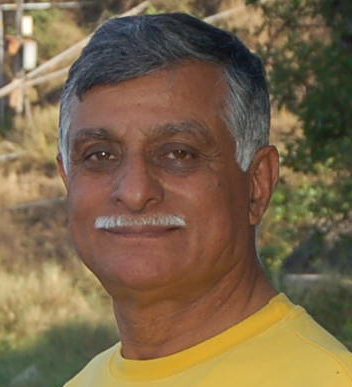Our Mother-tongue and Our Apathy Towards It
By Maharaj Krishen Raina
Kashmiri language, our mother tongue
is really in a bad shape.
Firstly, we reduced it to a third
category language, taking pride to
speak in English (followed by Hinglish or
Hindustani) most of the time and with most
of our intimates, even with our spouse and
children. Our logic is simple; what use is the
language which can not give us degrees and
livelihood? What use again when it is not
spoken anywhere in the world except
Kashmir where our chances of going back are
remote. Arguments may sound convincing
but we conveniently forget that a language
(read mother-tongue) not only acts as a
binding force for a community, but also
confers upon it a distinct mark of
identification. Shri A.K.Misri of Bandra,
Mumbai advocates speaking in Kashmiri not
only because this way we can keep our
mother-tongue alive, but we can also secretly
communicate with each other if cornered in
an alien atmosphere. Apart from spoken
words, literature is a vast medium which
nurtures and promotes a language and
preserves it for posterity.
Till 1990, most of the literary works
created in Kashmiri language, whether by
Kashmiri Muslims or by Kashmiri Pandits,
were in Nastaliq, the Persio-Urdu Script. This
script was the officially recognized script for
Kashmiri language (and still is), recognized not
only by the government of Jammu and Kashmir
but also by the Government of India. One
could claim government grant for a
publication only if his/her creation was in this
script. This treatment discouraged those who
wanted to write in Devanagari Script.
Post 1990 exodus, there was a big change.
KPs started writing in
Devanagari Script in a big
way and plethora of
literature got churned out
in community magazines
throughout the country.
While, this was considered
a good omen for the
Kashmiri literature, it brought to notice
another big challenge in the shape of varied
scripts adopted by the writers. Every writer
had his/her own way of writing, using dots,
lines, circles etc. at will. There was no
coordination and no conformity in writing.
Koshur Samachar of New Delhi assumed
central importance in this regard. It used a
set of diacritical marks to indicate vowels
peculiar to Kashmiri language with the Nagari
letters, but devising a universally acceptable
uniform script remained a problem. In
December 1995, a committee of the editors
of Koshur Samachar (New Delhi), Kashyap
Samachar (Jammu) and the Secretary of the
Vikalp (Delhi) met and agreed on adopting
certain diacritical marks for the peculiar
Kashmiri sounds. The linguistic experts
however were not fully satisfied. They
wanted to do some more work to upgrade
the script by modifying the already employed
symbols and diacritical marks, to suit
requirement of the language. This led to
formation of an expert committee led by Dr.
Roop Krishen Bhat, which organized various
workshops to finalise the Script. The experts
who worked hard along with Dr. Roop Krishen
Bhat included Dr.S.N.Bhat Haleem, Dr.
S.S.Toshakhani, Dr. O.N.Koul, Prof.
C.L.Sapru, Prof. R.L.Shant, Dr. S.N.Raina, Dr.
R.K.Bhat and Dr. Raj Nath Bhat. As a
software expert, Shri Sandeep Bhat of Pune
was closely associated with the Committee.
Shri M.K.Kaw, the then Secretary, Ministry
of Human resources, Government of India
also showed keen interest in devising this
material in the interest of Kashmiri
language. Subsequently, a Primer and a
Reader, edited by Dr. Roop Krishen Bhat
were released by the Central Institute of
Indian Languages, Mysore in association
with Samprati, Jammu in August 2003, thus
providing a complete Standardised
Devanagari Script for Kashmiri. Project ZAAN
of Mumbai also released the revised
version of ‘Basic Reader for KashmiriLanguage’ employing the Standardised
Devanagari-Kashmiri Script, in June 2004.
Shri Sandeep Bhat developed the exclusive
software for the language named ‘Arinimal’around the same time. In due course of time,an upgraded software namely Akruti-
Kashmiri-Arinimal Engine was developed by
the Cyberscape Multimedia Ltd. at a cost of
about Rs. 75000.00. This software was made
available free of cost at the All India
Kashmiri Samaj, New Delhi.
There are only a few KP journals in India
which include Kashmiri Sections. It is very
unfortunate that all of them are not
employing the Standardised Devanagari-Kashmiri Script for the Kashmiri language.
Koshur Samachar of New Delhi, which is a
prestigious magazine of the KP Community,
in particular has been using the same old
scripts, varying from author to author, thus
nullifying all the good work done by experts
over the years. In spite of the software made
available free of cost by the All India Kashmiri
Samaj, New Delhi, one fails to understand
what prohibits a prime magazine of the
community to switch over to new Script. All
those who love this language and who want
this language not to perish but to flourish
along with its scripts, need to come forward
and impress upon the authors, printers,
editors and proof readers of all the
community magazines to switch over to new
Script so that there is uniformity in writing
which in turn wi ll make it easily
comprehensible. This will be a small but an
important step in the direction of preserving
and promoting our mother-tongue.
It is worth mentioning here that non-Kashmiris like Pravin Satpute of Maharashtra
and Anshuman Pandey of University of
Michigan, USA have been working on
technical aspects of the Kashmiri Scripts for
a long time. Pravin Satpute is labouring hard
with the Commission of Scientific and
Technical Terminology, Government of India
to get the special characters of the
Standardised Devanagari-Kashmiri Script
included in the UNICODE and Anshuman
Pandey has already submitted (and
reportedly accepted) a proposal to Encode
the Sharada Script in ISO/IEC. There are some
more from our own biradari involved in the
process at various levels who deserve kudos
but lack of interest of the general masses in
their own mother-tongue is a matter of great
concern. It is still time we ponder over it.
Source: Milchar
| 













No one has commented yet. Be the first!